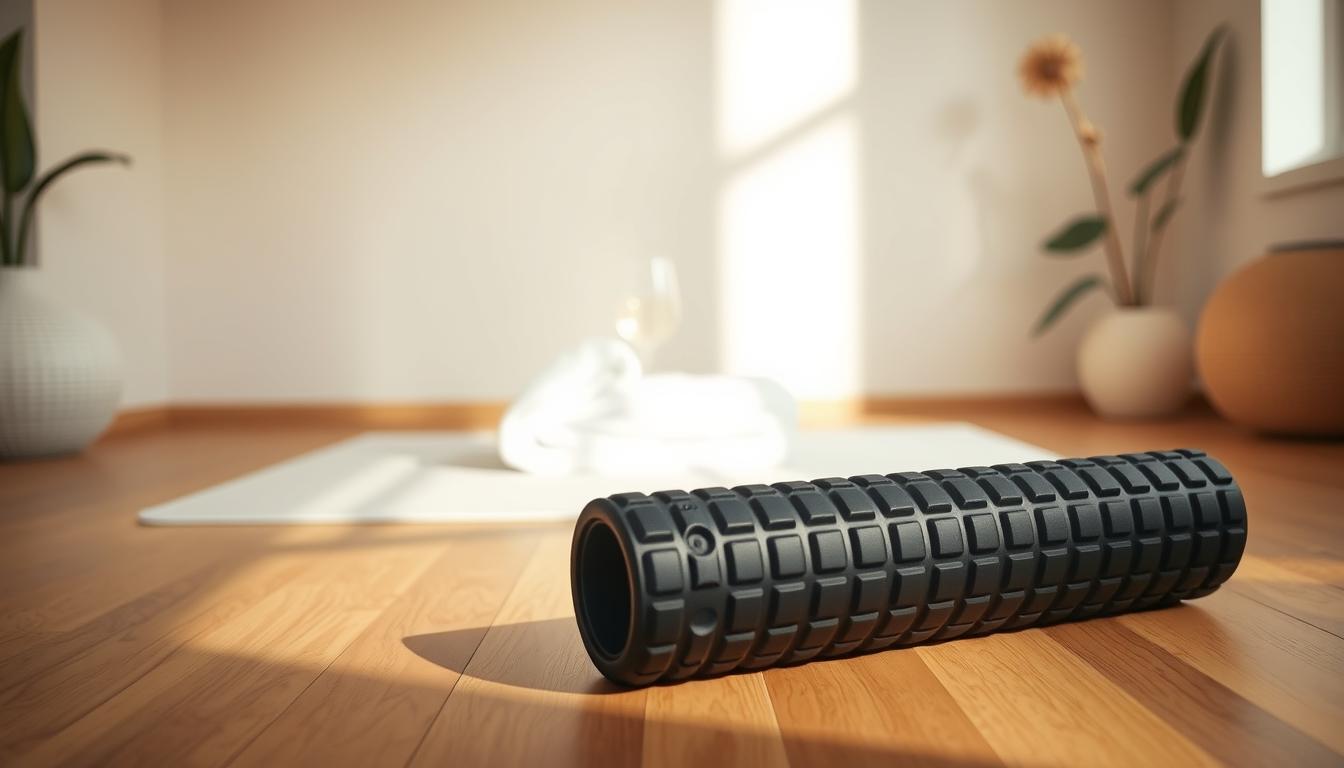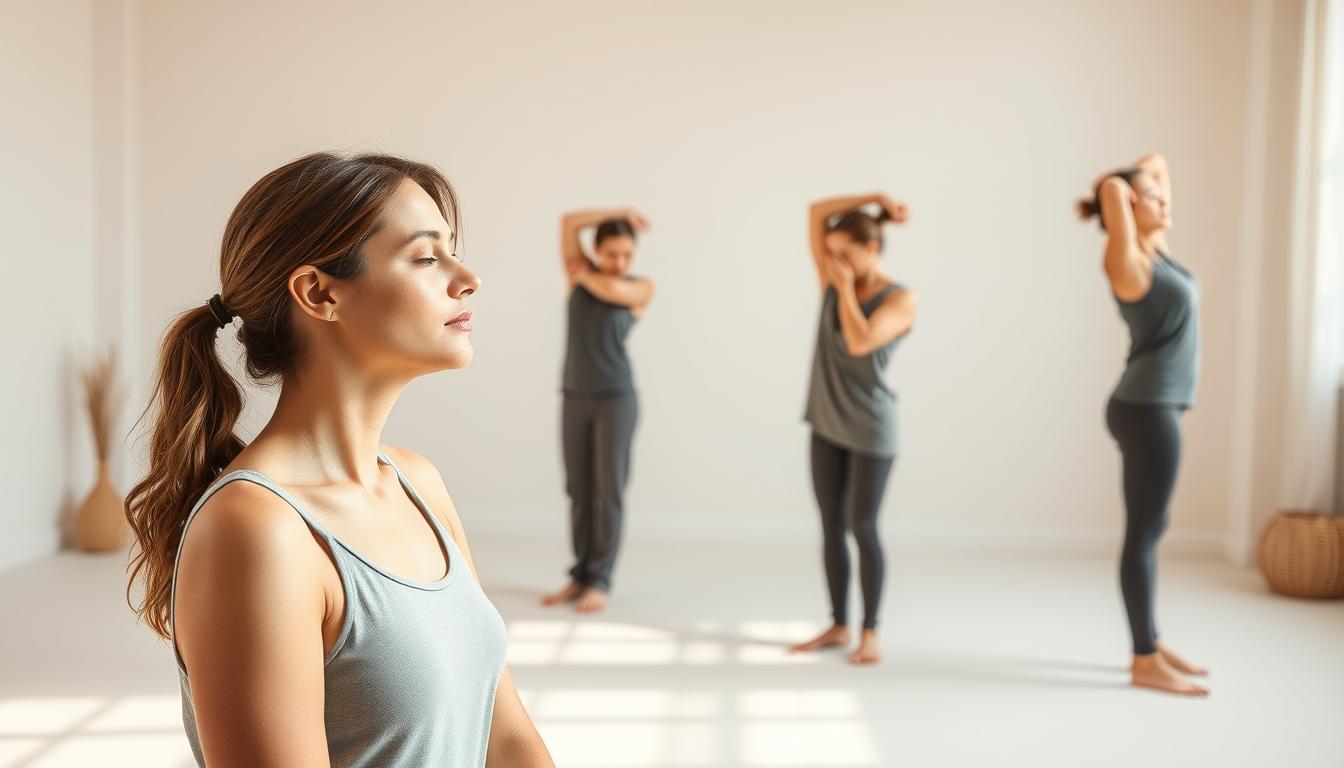Many people suffer from neck pain, often due to bad posture, stress, or repeating the same movements. This guide introduces easy exercises for neck pain relief. Adding these simple stretches to your day can help reduce pain. They can also improve how you feel overall. By learning about these exercises, you’ll see how they can be a useful way to deal with neck pain. Let’s find out how regular exercise can change the health of your neck.
Understanding Neck Pain
Neck pain affects millions in the United States. It comes from things like muscle strain, bad posture, and injuries. Knowing how the neck works is key to understanding neck pain. The neck has muscles, ligaments, and discs that help keep it healthy and moving.
To understand neck pain, we need to see how its parts support our body. When they get hurt or stressed, we feel pain and can’t move well. Knowing what causes neck pain is the first step to getting better.
Learning about neck anatomy helps us spot neck pain symptoms. This knowledge helps us make smart choices about treating pain and improving our neck’s health.
Common Causes of Neck Pain
Many people face neck pain daily for different reasons. Poor posture from sitting at a desk too long or using smartphones a lot is a big cause. This bad habit can hurt over time, so it’s key to know how to prevent it.
Accidents or sports can also hurt your neck. Such events can lead to sharp pain, needing the right care and steps to avoid future pain. Plus, doing the same things over and over, like staring at your phone, can make neck muscles sore.
Knowing what causes neck pain helps you figure out why it happens to you. When you understand how slouching and stress hurt your neck, you can find ways to feel better with specific exercises.
Benefits of Neck Exercises
Regular neck exercises have many benefits. They help strengthen your neck and support the spine. This makes it easier to avoid pain and injuries from bad posture or sitting too much.
Neck exercises also improve your flexibility. Being more flexible means you can move more easily and feel less stiff. This can make your upper body feel more relaxed and comfortable.
Doing these exercises often can help you keep a good posture. A good posture reduces stress on your neck and shoulders. This is key for avoiding pain. Neck exercises are vital for anyone looking to improve their health.
How to Get Started with Neck Relief Exercises
It’s key to prep before starting neck exercises. Talk to a doctor to make sure the exercises are right, especially if you have health issues. This check-up ensures you can start neck exercises safely to ease pain.
Doing a warm-up is crucial as it gets muscles ready for what’s to come. By doing mobility work, you can become more flexible and avoid getting hurt. Here are steps to lay a good groundwork:
- Consult a healthcare provider or physical therapist for personalized recommendations.
- Begin with a few minutes of gentle neck movements to promote blood flow.
- Incorporate dynamic stretches that focus on neck mobility to efficiently warm up the area.
- Gradually transition to beginner exercises that strengthen the surrounding muscles.
Starting with a solid warm-up helps make the exercises safer. It also helps keep your neck healthy over time.
Beginner’s Guide to Neck Pain Relief Exercises
Starting neck exercises is a great way to lessen neck pain and get better movement. It’s key to begin with a dynamic warm-up to ready your neck and shoulders. This approach boosts blood flow and flexibility, setting you up for better exercises.
Dynamic Warm-Up Techniques
Before exercising, do dynamic warm-ups to wake up your neck and shoulder muscles. Effective moves include:
- Neck rolls to loosen tight muscles
- Shoulder shrugs for relaxation
- Gentle head tilts to stretch the neck
- Arm circles that promote shoulder mobility
These actions help increase motion range, preparing your neck to handle strain better. Adding them to your warm-up makes workouts safer.
Importance of Stretching and Strengthening
Stretching and strengthening are crucial for a good neck exercise plan. Stretching makes you flexible, and strength exercises support your neck. Do both:
- Incorporate static stretches after exercising to avoid stiffness
- Add isometric holds for neck stability
- Use resistance bands for extra strength
This mix reduces pain and strengthens the neck area against injuries. By following these steps, you create a strong foundation for your neck and shoulders. Your exercise experience improves too.
Dynamic Stretches for the Neck
Adding dynamic neck stretches to your daily routine boosts neck mobility and eases shoulder tension. These stretches help keep your neck flexible. This prevents stiffness and is key to staying well.
Neck Rolls for Mobility
Neck rolls greatly improve neck flexibility. Here’s how to do a dynamic neck roll properly:
- Stand or sit with your back straight.
- Relax your shoulders, letting your arms rest at your sides.
- Gently tilt your head to one side, bringing your chin down to your chest.
- Slowly roll your head to the opposite side, making a complete circle.
- Do this motion 5 to 10 times in each direction.
Doing this neck mobility exercise often keeps your neck joints healthy. It also boosts your range of motion.
Shoulder Rolls to Relieve Tension
Shoulder rolls are great for enhancing neck mobility and easing shoulder tension. Here’s how to do shoulder rolls:
- Stand with your feet apart, about shoulder-width.
- Keep your arms relaxed at your sides.
- Circle your shoulders forward 5 to 10 times in a circular motion.
- Then, switch and roll them backward for 5 to 10 more times.
This exercise is simple but very effective. It helps release tension in the upper back and shoulders. You’ll feel more relaxed after.

Strengthening Exercises for Neck and Shoulders
Adding neck-strengthening exercises to your daily routine boosts neck stability and shoulder health. We focus on isometric holds and resistance training to safely increase neck strength. These methods help build strength in a way that lasts.
Isometric Holds for Strength
Isometric holds are key for building neck strength without moving much. By contracting muscles while keeping the neck still, strength and endurance improve. Here are important isometric exercises:
- Neck Front Hold: Press your forehead against your hands without moving your head.
- Neck Side Hold: Place your palm against your temple and push against it, engaging the neck muscles.
- Neck Back Hold: Sit upright and press the back of your head into a wall or your hands, strengthening the posterior neck.
Resistance Exercises with Bands
Neck resistance training works well with bands. These exercises enhance neck and shoulder muscle strength, leading to better posture. Adding these moves to your routine is beneficial:
- Face Pulls: Attach a band to a sturdy surface, grasp the ends, and pull towards your face while keeping elbows high.
- Lat Pulldowns: Secure the band overhead, kneel, and pull the band down to engage a variety of upper body muscles.
- Deadlifts with Bands: Stand on the band and perform standard deadlifts to engage the shoulder and neck support muscles.
Static Stretches for Post-Exercise Recovery
Adding static stretches after working out is key for a good recovery. These help your muscles slowly get back to normal, reducing tightness and increasing flexibility. They can also ease muscle tension from exercising, especially around the neck and shoulders.
Pec Stretch for Upper Body Relief
The pec stretch is great for easing tightness in your chest and shoulders. To do this stretch, stand with your arms out at shoulder level. Pull your shoulder blades together and arch your back slightly. Stay like this for 20 to 30 seconds, taking deep breaths. This helps improve your posture and loosen tightness in your upper body.
Child’s Pose for Back and Neck Flexibility
Child’s Pose is a great way to stretch your neck and back. Start on your hands and knees, then sit back on your heels and reach your arms out. Stay there between 30 seconds and a minute, breathing deeply. This move is great for relaxing after exercise, helping your spine to stretch and relax.
Creating a Routine for Neck Pain Relief
Creating a routine for easing neck pain is crucial for lasting comfort. Doing neck exercises regularly and following a strict schedule helps lessen pain and improves flexibility.
To build an effective routine, keep these tips in mind:
- Plan to exercise three to four times a week at set times.
- Include a variety of stretches and strengthening exercises for overall improvement.
- Start with short exercise periods and increase them as you get stronger.
- Track your progress to fine-tune your routine as you go along.
Tracking your progress reveals what works best for your neck’s strength and flexibility. Writing down your routine and exercises helps you stick to your plan, promoting ongoing health.
Conclusion
We’ve talked about how to ease neck pain, touching on exercises that help. These exercises make your neck and shoulders move better and get stronger. They also lower stress and tension. If you do these regularly, you can fix current neck problems and stop future ones.
It’s important to add these exercises to your daily life. This helps you take care of your neck health on your own. And if something doesn’t feel right, getting advice from a doctor is a smart move. They can offer exercises that fit your exact needs.
Living an active life where you focus on keeping your neck healthy is key. By sticking to these tips, you’re on your way to a life with less neck pain. This not only feels better but also improves your overall health.



